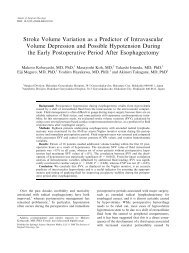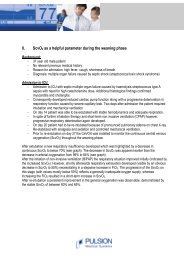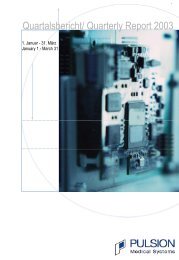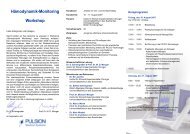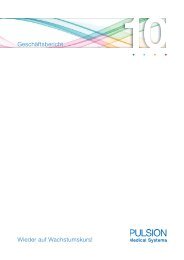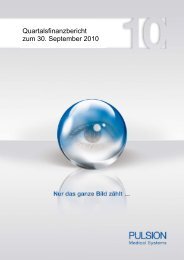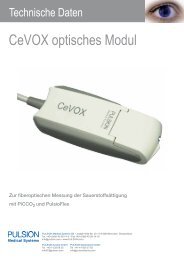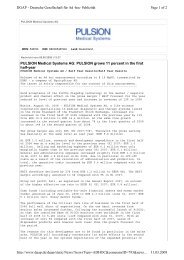The Accuracy of the Vigileo/FloTrac System Has Been Improved ...
The Accuracy of the Vigileo/FloTrac System Has Been Improved ...
The Accuracy of the Vigileo/FloTrac System Has Been Improved ...
Create successful ePaper yourself
Turn your PDF publications into a flip-book with our unique Google optimized e-Paper software.
<strong>The</strong> <strong>Accuracy</strong> <strong>of</strong> <strong>the</strong> <strong>Vigileo</strong>/<strong>FloTrac</strong> <strong>System</strong> <strong>Has</strong> <strong>Been</strong> <strong>Improved</strong>—Follow-up<br />
After a S<strong>of</strong>tware Update: A Blinded Comparative Study <strong>of</strong><br />
30 Cardiosurgical Patients<br />
To <strong>the</strong> Editor:<br />
<strong>The</strong> <strong>Vigileo</strong> pulse contour cardiac output system (Edwards Lifesciences, Irvine, CA), especially in its first version, was<br />
controversial regarding its accuracy. 1-12 <strong>The</strong> authors presented an evaluation <strong>of</strong> <strong>the</strong> system in its first s<strong>of</strong>tware version (1.01). 1<br />
Since <strong>the</strong>n, <strong>Vigileo</strong> has undergone fur<strong>the</strong>r s<strong>of</strong>tware development: <strong>the</strong> algorithm has been improved, and <strong>the</strong> data sampling rate<br />
has been accelerated from 20 minutes to 1 minute. This was reason enough to perform a second validation study <strong>of</strong> <strong>the</strong><br />
improved s<strong>of</strong>tware (version 1.10) with <strong>the</strong> same method as before in order to evaluate <strong>the</strong> current status <strong>of</strong> its accuracy. Only<br />
<strong>the</strong> site <strong>of</strong> <strong>the</strong> arterial ca<strong>the</strong>ter differs from <strong>the</strong> previous study, since we found that <strong>the</strong> results obtained by femoral artery<br />
ca<strong>the</strong>ters did not differ from those obtained by radial artery ca<strong>the</strong>ters. <strong>The</strong>refore, we used only radial artery cannulae in this<br />
investigation.<br />
After approval by <strong>the</strong> ethics committee and with written informed consent, 30 patients undergoing coronary artery bypass graft surgery<br />
with extracorporeal circulation were studied. <strong>The</strong> statistical evaluation was performed by using <strong>the</strong> Bland-Altman 13 method <strong>of</strong> analysis.<br />
In addition, a �20% deviation from <strong>the</strong> pulmonary artery ca<strong>the</strong>ter <strong>the</strong>rmodilution technique was evaluated (20% criteria). 14 Synchronized<br />
measurements using both methods were made at 7 predefined time points, intra- and postoperatively, producing 210 data pairs. <strong>The</strong><br />
demographic data <strong>of</strong> <strong>the</strong> included patients were found comparable. Thus, <strong>the</strong> improvements regarding <strong>the</strong> precision are not influenced by<br />
patient characteristics but by <strong>the</strong> modified properties <strong>of</strong> <strong>the</strong> <strong>Vigileo</strong> system itself.<br />
<strong>The</strong> recorded data <strong>of</strong> 6 <strong>of</strong> <strong>the</strong> 30 patients had to be excluded because <strong>of</strong> technical complications (loss <strong>of</strong> data or incorrect recording<br />
because <strong>of</strong> <strong>the</strong> complicated handling <strong>of</strong> <strong>the</strong> data transfer). Thus, only 138 <strong>of</strong> <strong>the</strong> 210 data pairs were available for analysis. A descriptive,<br />
cumulative presentation <strong>of</strong> all data pairs is shown in Figure 1. Thirty-one percent <strong>of</strong> all measurements at <strong>the</strong> 7 time points did not meet<br />
<strong>the</strong> 20% criteria (former study, 46%), which is graphically shown in Figure 1. <strong>The</strong> Bland-Altman plots showed similar results. <strong>The</strong><br />
cumulative presentation <strong>of</strong> all data in <strong>the</strong> Bland-Altman diagram is shown in Figure 2. At <strong>the</strong> low bias between <strong>the</strong> methods (0.04 L/min),<br />
<strong>the</strong> limits <strong>of</strong> agreement were �2.13 L/min (�3.0 L/min in <strong>the</strong> former study).<br />
In our first evaluation, <strong>the</strong> system had not met <strong>the</strong> 20% criteria (ie, 75% <strong>of</strong> all data pairs should be within a �20% range).<br />
In <strong>the</strong> new evaluation, this situation has improved; 69% <strong>of</strong> data pairs were found within <strong>the</strong> �20% limits. <strong>The</strong> results are<br />
better, and <strong>the</strong> values are now very close to <strong>the</strong> strict limits published by Critchley and Critchley. 14<br />
Reflecting <strong>the</strong> Critchley criteria (20% limits) and <strong>the</strong> results according to Bland-Altman (1.96� ��2.13 L/min), <strong>the</strong> accuracy <strong>of</strong> <strong>the</strong><br />
<strong>Vigileo</strong> system has improved, although <strong>the</strong> narrow precision criteria are not yet completely met. <strong>The</strong>refore, <strong>the</strong> authors are <strong>of</strong> <strong>the</strong> opinion<br />
that <strong>the</strong> device should not yet be used during and after cardiac surgery because <strong>the</strong> deviation from <strong>the</strong> clinical standard method is still out<br />
<strong>of</strong> scale. However, we expect that fur<strong>the</strong>r development <strong>of</strong> <strong>the</strong> system will improve its accuracy. Future validation studies after evolution<br />
<strong>of</strong> <strong>the</strong> <strong>Vigileo</strong> system should be considered.<br />
PA (L/min)<br />
12.0<br />
11.0<br />
10.0<br />
9.0<br />
8.0<br />
7.0<br />
6.0<br />
5.0<br />
4.0<br />
3.0<br />
2.0<br />
1.0<br />
ARTICLE IN PRESS<br />
0.0<br />
0.0 1.0 2.0 3.0 4.0 5.0 6.0 7.0 8.0 9.0 10.0 11.0 12.0<br />
<strong>Vigileo</strong> (L/min)<br />
y = 0.5027x + 2.5402<br />
R 2 = 0.323<br />
Andreas Zimmermann, MD*<br />
Joachim Steinwendner, PhD*<br />
Stephan H<strong>of</strong>bauer, MD*<br />
Michael Kirnbauer, MD*<br />
Jens Schneider, MD†<br />
Leo Moser, MD*<br />
Fig 1. A cumulative presentation <strong>of</strong> all data pairs. Unit: L/min. PA, pulmonary artery ca<strong>the</strong>ter. <strong>The</strong> broad line is <strong>the</strong> line <strong>of</strong> optimum agreement.<br />
<strong>The</strong> small lines show �20% criterion <strong>of</strong> agreement; 31% (n � 43) <strong>of</strong> all data exceeded <strong>the</strong> 20% limits. (Color version <strong>of</strong> figure is available online.)<br />
Journal <strong>of</strong> Cardiothoracic and Vascular Anes<strong>the</strong>sia, Vol xx, No x (Month), 2009: pp xxx<br />
1
difference: (<strong>Vigileo</strong>-PA) (L/min)<br />
4.00<br />
3.00<br />
2.00<br />
1.00<br />
0.00<br />
0.00 1.00 2.00 3.00 4.00 5.00 6.00 7.00 8.00 9.00<br />
-1.00<br />
-2.00<br />
-3.00<br />
-4.00<br />
ARTICLE IN PRESS<br />
2 LETTER TO THE EDITOR<br />
mean: (<strong>Vigileo</strong>+PA)/2 (L/min)<br />
Gernot Pauser, MD*<br />
Departments <strong>of</strong> *Anaes<strong>the</strong>siology and Intensive Care Medicine and †Cardiac Surgery<br />
Paracelsus Medical University<br />
Salzburg, Austria<br />
REFERENCES<br />
1. Zimmermann A, Kufner C, H<strong>of</strong>bauer S, et al: <strong>The</strong> accuracy <strong>of</strong> <strong>the</strong> <strong>Vigileo</strong>/<strong>FloTrac</strong> continuous cardiac output monitor. J Cardiothorac Vasc<br />
Anesth 22:388-393, 2008<br />
2. Button D, Weibel L, Reu<strong>the</strong>buch O, et al: Clinical evaluation <strong>of</strong> <strong>the</strong> <strong>FloTrac</strong>/<strong>Vigileo</strong> system and two established continuous cardiac output<br />
monitoring devices in patients undergoing cardiac surgery. Br J Anaesth 99:329-336, 2007<br />
3. Cannesson M, Att<strong>of</strong> Y, Rosamel P, et al: Comparison <strong>of</strong> <strong>FloTrac</strong> cardiac output monitoring system in patients undergoing coronary artery<br />
bypass grafting with pulmonary artery cardiac output measurements. Eur J Anaes<strong>the</strong>siol 24:832-839, 2007<br />
4. Compton FD, Zukunft B, H<strong>of</strong>fmann C, et al: Performance <strong>of</strong> a minimally invasive uncalibrated cardiac output monitoring system<br />
(Flotrac/<strong>Vigileo</strong>) in haemodynamically unstable patients. Br J Anaesth 100:451-456, 2008<br />
5. de Waal EE, Kalkman CJ, Rex S, et al: Validation <strong>of</strong> a new arterial pulse contour-based cardiac output device. Crit Care Med 35:1904-1909,<br />
2007<br />
6. Lorsomradee S, Cromheecke S, De Hert SG: Uncalibrated arterial pulse contour analysis versus continuous <strong>the</strong>rmodilution technique: Effects<br />
<strong>of</strong> alterations in arterial waveform. J Cardiothorac Vasc Anesth 21:636-643, 2007<br />
7. Mayer J, Boldt J, Schollhorn T, et al: Semi-invasive monitoring <strong>of</strong> cardiac output by a new device using arterial pressure waveform analysis:<br />
a comparison with intermittent pulmonary artery <strong>the</strong>rmodilution in patients undergoing cardiac surgery. Br J Anaesth 98:176-182, 2007<br />
8. Mayer J, Boldt J, Wolf MW, et al: Cardiac output derived from arterial pressure waveform analysis in patients undergoing cardiac surgery:<br />
Validity <strong>of</strong> a second generation device. Anesth Analg 106:867-872, 2008<br />
9. Mehta Y, Chand RK, Sawhney R, et al: Cardiac output monitoring: Comparison <strong>of</strong> a new arterial pressure waveform analysis to <strong>the</strong> bolus<br />
<strong>the</strong>rmodilution technique in patients undergoing <strong>of</strong>f-pump coronary artery bypass surgery. J Cardiothorac Vasc Anesth 22:394-399, 2008<br />
10. Perret F, Mooser V, Hayoz D, et al: Evaluation <strong>of</strong> arterial compliance-pressure curves. Effect <strong>of</strong> antihypertensive drugs. Hypertension<br />
18:II77-II83, 1991<br />
11. Sander M, Spies CD, Foer A, et al: Cardiac output measurement by arterial waveform analysis in cardiac surgery—A comparison <strong>of</strong><br />
measurements derived from waveforms <strong>of</strong> <strong>the</strong> radial artery versus <strong>the</strong> ascending aorta. J Int Med Res 36:414-419, 2008<br />
12. Sander M, Spies CD, Grubitzsch H, et al: Comparison <strong>of</strong> uncalibrated arterial waveform analysis in cardiac surgery patients with<br />
<strong>the</strong>rmodilution cardiac output measurements. Crit Care 10:R164, 2006<br />
13. Bland JM, Altman DG: Statistical methods for assessing agreement between two methods <strong>of</strong> clinical measurement. Lancet 1:307-310, 1986<br />
14. Critchley LA, Critchley JA: A meta-analysis <strong>of</strong> studies using bias and precision statistics to compare cardiac output measurement techniques.<br />
J Clin Monit Comput 15:85-91, 1999<br />
2.089<br />
0.04<br />
-2.170<br />
Fig 2. Pooled Bland-Altman plot <strong>of</strong> <strong>Vigileo</strong><br />
and pulmonary artery ca<strong>the</strong>ter data; 95% prediction<br />
intervals correspond to <strong>the</strong> limits <strong>of</strong> agreement<br />
(1.96� ��2.13 L/min). (Color version <strong>of</strong><br />
figure is available online.)<br />
doi:10.1053/j.jvca.2008.12.012





